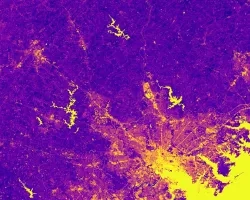Alaska ecological conservation (2024 Spring)
Team: Christian Sarro (Project Lead), Mahnoor Naeem, Benjamin Silver, Levi Mitchell
Summary: Each fall, caribou (Rangifer tarandus) in the Western Arctic Herd migrate hundreds of kilometers across northwestern Alaska to acquire seasonal resources and reach wintering grounds. Various rivers intersect migration paths, and caribou can only cross over open water or high-ice extents but are unable to cross rivers in stages of partial freezing. Recent temperature increases in Alaska can alter the timing and duration of ice formation periods, impeding migratory patterns. The Massachusetts NASA DEVELOP team partnered with the National Park Service in Alaska to detect river ice onset dates and formation periods using Landsat 8 Operational Land Imager and Landsat 9 Operational Land Imager-2, Sentinel-1 C-band Synthetic Aperture Radar and Sentinel-2A/B MultiSpectral Instrument imagery in Google Earth Engine. This feasibility analysis measured ice coverage using the Normalized Difference Infrared Index, Relative Difference River Ice, and Vertical-Vertical/Vertical-Horizontal backscatter values based on the spectral and surface characteristics of rivers. The team produced annual freezing timelines, time series plots, and maps at three river stretches to analyze river ice phenology changes. Radar imagery assessed ice coverage more accurately, while optical imagery better identified ice onset dates. Meanwhile indices were unable to robustly establish ice formation thresholds across the study period. These study results can help the National Park Service to better evaluate spatiotemporal migratory shifts and contextualize recent regional caribou declines


